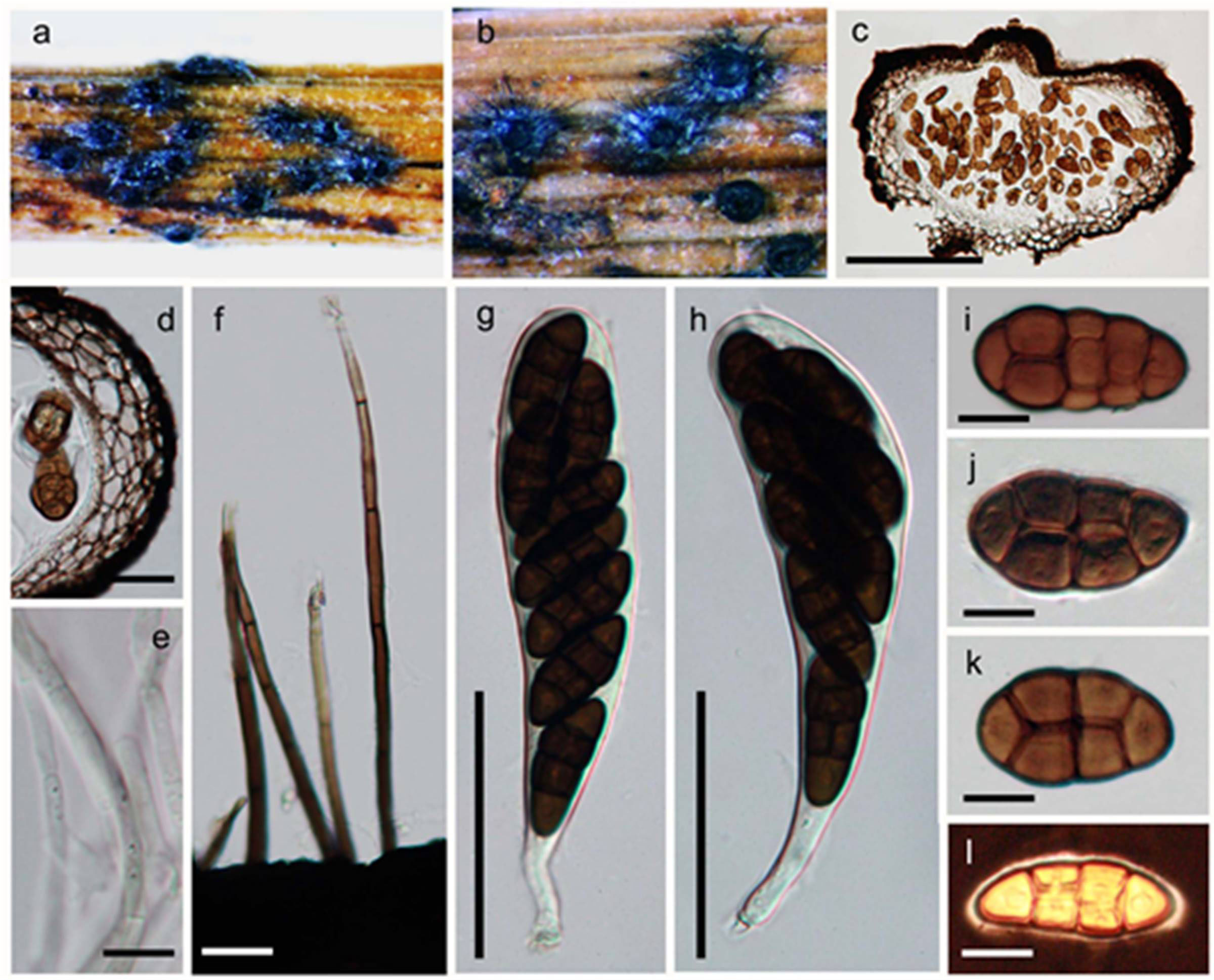Diademosa californiana (M.E. Barr) Shoemaker & C.E. Babc.
Basionym: Graphyllium californianum M.E. Barr, Mem. N. Y. bot. Gdn 62: 40 (1990).
Saprobic on stem and wood. Sexual morph: Ascomata 200–365 × 240–425 µm ( = 315 × 275 µm, n = 10), immersed, initially erumpent becoming superficial, scattered, depressed-globose, some flattened at the base, opening a disc-like lid of brown prismatic cells with setae. Peridium 24–59 µm ( = 32 µm, n = 20), composed brown pseudoparenchyma cells of textura angularis. Hamathecium of dense, 2–3 µm diam. ( = 2 µm, n = 20), numerous, septate, hyaline, cellular pseudoparaphyses. Asci 140–175 × 24–28 µm ( = 150 × 26 µm, n = 20), 8-spored, bitunicate, fissitunicate, clavate with short narrow pedicel and minute ocular chamber. Ascospores 50–65 × 26–32 µm ( = 57 × 29 µm, n = 40), biseriate or discontinuously arranged, partially overlapping, fusiform, straight, cylindrical; frequently circular in section but narrowing to one end, with transverse and vertical septa, muriform, constricted at first septum, pale brown to dark brown, smooth walled with narrow sheath. Asexual morph: unknown.
Material examined: USA, Bump-Cold Boiling Lake Trail, Lassen Volcanic National Park, Shasta, California, on branch of Wyethia Nutt (Asteraceae), 12 July 1966, W.B. Cooke & D.L. Hawksworth. (NY, holotype).
Notes: Diademosa was established by Shoemaker and Babcock (1992) and typified by D. californiana, based on the ascomatal opening via a circular lid and ascospores being frequently circular in end view. Diademosa californiana was initially introduced as Graphyllium californianum by Barr (1990) and referred to Hysteriaceae based on the pore or slit like opening. Re-examination of the type specimens by Shoemaker and Babcock (1992) concluded that Diademosa opened by a flat lid similar with Diadema and assigned it in to Diademaceae. The lid is hard to observe in sections unless they are mounted directly in lactic acid because excessive swelling occurs in water (Shoemaker and Babcock 1992). Diademosa differs from Comoclathris in having cylindrical ascospores; frequently circular in section, but narrowing to one end of the spores, as compared with the flattened ascospores of Comoclathris. Ariyawansa et al. (2014a) placed Diademosa in Pleosporaceae based on its similarities with other genera in this family, but confirmation of the phylogenetic status of this genus depends on recollecting the fungus and epitypification with molecular sequences.
Fig 1 Diademosa californiana (holotype) a-b. Ascomata on host substrate.c. Section of ascomata. d. Section of peridium. e. Septate, hyaline, cellular pseudoparaphyses f. Light to dark brown setae. g-h. Ascus with minute pedicel bearing irregularly arranged 8 ascospores. i-k. Ascospores. l. Ascospore stained with Indian ink and showing narrow sheath. Scale bars: d-e=200 μm, f-h=10 μm, g-h=50 μm, i-l=10 μm.

